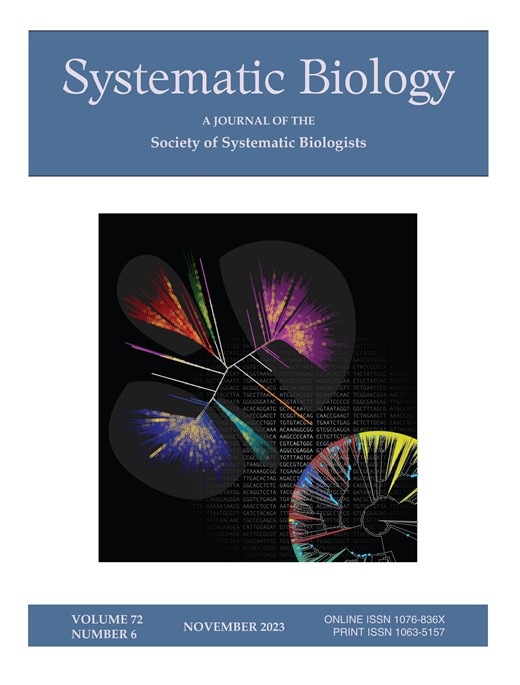Revisiting the Multispecies Coalescent Model fit with an example from a complete molecular phylogeny of the Liolaemus wiegmannii species group (Squamata: Liolaemidae).
IF 5.7
1区 生物学
Q1 EVOLUTIONARY BIOLOGY
引用次数: 0
Abstract
Departures from the Multispecies Coalescent (MSC) assumptions could cause artefactual topologies and node height estimates, and therefore, trees inferred without MSC model fit testing could potentially misrepresent an accurate approximation of the evolutionary history of a group. The current implementation of MSC model testing for non-genomic level molecular markers cannot process trees estimated from BEAST 2, limiting its application for large datasets of sequence-based markers. Here we recode functions of the R package P2C2M to assess model fit to the MSC and apply this new implementation, which we named P2C2M2, to test the MSC model in a 16-loci dataset of 42 lizard species focused on the Liolaemus wiegmannii group. We found strong evidence of model departures in several loci, possibly due to historical gene flow, which could also be causing an unexpected position of the L. wiegmannii group within the L. montanus section of Eulaemus, when hybridization is not accounted for. The L. anomalus group is inferred as the closest to the L. wiegmannii group when gene flow is incorporated via a Multispecies Network Coalescent model, and a reticulation, suggesting historical gene flow between the L. wiegmannii and L. montanus groups is inferred, which has not been previously reported. We argue that there are at least three sources of discrepancy between the literature and the node ages estimated in our study: the use of strict molecular clocks without statistical justification, misplaced fossil calibrations, and the estimation of coalescent times instead of species divergence times. We encouraged systematists to routinely test the fit of the MSC model when estimating species trees using sequence-based markers, and to follow a phylogenetic network approach when both this test is significant and when historical gene flow is considered one plausible source of the departure from the MSC model.重新审视多物种聚结模型,以一个完整的分子系统发育的例子来拟合Liolaemus wiegmannii种群(Squamata: Liolaemidae)。
偏离多物种聚合(MSC)假设可能会导致人为的拓扑结构和节点高度估计,因此,未经MSC模型拟合检验推断的树可能会错误地反映一个群体进化历史的准确近似值。目前实施的非基因组水平分子标记的MSC模型测试不能处理从BEAST 2估计的树,限制了其在基于序列的标记的大型数据集的应用。在这里,我们重新编码R包P2C2M的功能,以评估模型与MSC的拟合性,并应用我们命名为P2C2M2的新实现,在以Liolaemus wiegmannii类群为重点的42种蜥蜴的16个位点数据集中测试MSC模型。我们在几个位点上发现了模型偏离的有力证据,可能是由于历史基因流动,这也可能导致L. wiegmannii群在Eulaemus的L. montanus部分中出现意外的位置,当没有考虑杂交时。通过多物种网络聚结模型(multi - species Network Coalescent model)和网状结构将L. wiegmannii类群与L. montanus类群的基因流结合,推测出L. wiegmannii和L. montanus类群之间的历史基因流,这在以前没有报道过。我们认为,文献和我们研究中估计的节点年龄之间至少有三个差异的来源:使用严格的分子钟而没有统计依据,错误的化石校准,以及估计成结时间而不是物种分化时间。我们鼓励系统学家在使用基于序列的标记估计物种树时,常规地测试MSC模型的拟合性,当这两个测试都很重要,并且当历史基因流被认为是偏离MSC模型的一个合理来源时,遵循系统发育网络方法。
本文章由计算机程序翻译,如有差异,请以英文原文为准。
求助全文
约1分钟内获得全文
求助全文
来源期刊

Systematic Biology
生物-进化生物学
CiteScore
13.00
自引率
7.70%
发文量
70
审稿时长
6-12 weeks
期刊介绍:
Systematic Biology is the bimonthly journal of the Society of Systematic Biologists. Papers for the journal are original contributions to the theory, principles, and methods of systematics as well as phylogeny, evolution, morphology, biogeography, paleontology, genetics, and the classification of all living things. A Points of View section offers a forum for discussion, while book reviews and announcements of general interest are also featured.
 求助内容:
求助内容: 应助结果提醒方式:
应助结果提醒方式:


